From “kampung boy” conservation force in the rainforest of Borneo
From “kampung boy” to conservation force in the Malaysian rainforest
Alissa Poh, special to mongabay.com
May 27, 2008
Waidi Sinun oversees three extraordinarily diverse conservation areas in the Malaysian rainforest, a career shaped by a love for the environment stemming from childhood memories, as well as the foundation that fostered his education.
|
|
Kampung—It’s the Malay word for “village,” where houses are built on stilts with roofs of atap, or woven palm-leaf thatch. Here, chasing chickens, spinning wooden tops, or hunting for frogs in paddy fields are still the main forms of entertainment for children, rather than YouTube videos or instant messaging.
“The rivers were extremely clean then,” Waidi Sinun reminisced of his boyhood days in Kampung Timbua, “so I spent a lot of time fishing, swimming, or berakit [rafting].” Now, more than three decades later, the 43-year-old Sinun still draws upon his love of water, but in a rather different way: He’s a forest hydrologist who spearheads three internationally recognized forest conservation efforts in Sabah, East Malaysia—the part of Borneo Island shaped like a dog’s head. The areas preserve a rich variety of flora and fauna unique to Asian tropical rainforests, making them noteworthy conservation zones.
Kampung Timbua, where Sinun grew up, lies close to the small town of Ranau at the foot of Mount Kinabalu, Southeast Asia’s highest peak. Since village life was extremely rural, with many children not going beyond education at the primary-school level, Sinun didn’t indulge in big dreams about his future. The Dusun (one of Sabah’s indigenous tribes) boy figured that he’d get what schooling he could, then take over managing his family’s rice farm.
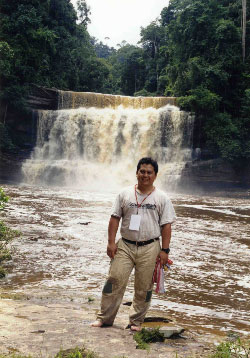 Sinun at Maliau waterfall |
His parents, however, had different ideas. They encouraged their son to keep up with his studies, refusing to let him stick to the status quo as just another “kampung boy.” Nor was Sinun daunted at the notion of studying by the light of a homemade kerosene lamp that had to be turned over every two to three minutes so the wick stayed lit.
When he was twelve, his excellent school results got the attention of Yayasan Sabah, a foundation established to help the rural people of Sabah benefit from the state’s considerable timber resources. “It’s called timber wealth redistribution,” Sinun explained. “They [the foundation’s managers] have used proceeds from timber resources to devise various programs so more children have a chance at secondary, even tertiary education, in both local and overseas institutions.”
With Yayasan Sabah’s financial support, Sinun went to high school in Perak, on the Malaysian peninsula. He did so well during his first three years there that the foundation decided to let him finish his high school education in Queensland, Australia. He then stayed on to get his bachelor’s degree in earth science at the Queensland University of Technology, graduating in 1986.
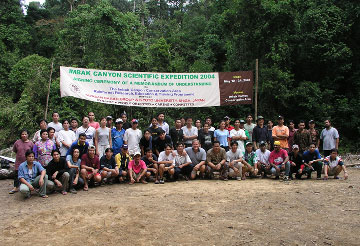 Imbak expedition |
“That was a bad year for graduates,” Sinun remarked. “Malaysia had been suffering an economic downturn since 1984, and I came back to an environment where there were more people looking for jobs than there were jobs available.” He wanted to be a mining geologist, and most of the jobs he applied for revolved around that field. But he grew frustrated with the lack of an immediate response. When he saw an advertisement from the University of Manchester in Britain, seeking a research assistant to work in a forest hydrology program, he pounced.
“I ended up doing two jobs at the same time,” Sinun said, “both as a research assistant and as a student in the university’s Master of Science program.” He focused on rainforest hydrology—how rainwater is transported after falling onto forested areas, and how it moves within soil layers underneath the rainforest floor before finally entering various streams and rivers.
By then, Sinun was hooked on forestry research; he couldn’t refuse an offer of funding from the same university to pursue his Ph.D. Even so, he wasn’t about to forget his roots. “The environment [in Ranau] was really pristine when I was young, with undisturbed forests and abundant wildlife, but sadly most of these have changed,” he lamented. So he decided to study the impact of forest destruction on streams in the highlands of Kinabalu, where he grew up. These ecosystems, called “montane forests,” grow at 900 meters (3000 feet) or more above sea level. In Sabah, they are found mostly in the Crocker Range and on Mount Kinabalu. Oak and chestnut trees are prevalent, although these often appear stunted due to strong winds and a harsh environment.
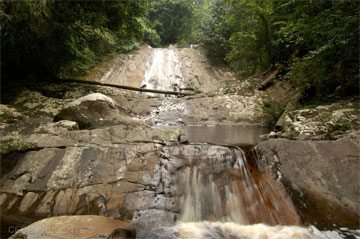 Imbak waterfall |
“I found that montane forests are very fragile, requiring a higher degree of care compared to lower and flatter [forest] areas,” Sinun said. “These areas are not only very sensitive to change; they’re among the most important regulators of streams, rivers, and ultimately the lives of people living downstream. So when it comes to land use management, we’d be wise to be especially careful about protecting these forests.”
Now back in his beloved Sabah, Sinun is kept busy working for the foundation to which he owes his initial leg-up in education. Yayasan Sabah manages the conservation areas of Danum Valley, Maliau Basin, and Imbak Canyon, under their Research and Development Division. Sinun has been involved with this two-year-old division from its conception, and is its current head.
One of the world’s wildest jungles
The island of Borneo, shared by three countries (Malaysia, Indonesia, and Brunei), also hosts the world’s oldest tropical rainforests—”about 70 to 100 million years old,” said Sinun. But for many Malaysians, perhaps especially those on the peninsula, rainforests are often taken for granted as just a part of the country. Few are aware that more than ten forest types grow in Sabah alone, due to soil and elevation influences. For instance, mangrove forests cover a greater area in Sabah than in other Malaysian states. Residents use the mangroves for firewood and charcoal production, and the trees’ massive, heavily-intertwined roots protect the coastline, providing quiet breeding grounds for fish and prawns. Lowland dipterocarp forests—Sabah’s major forest type—are taller than any other broad-leaved tropical rainforest in the world, with a high market value for timber.
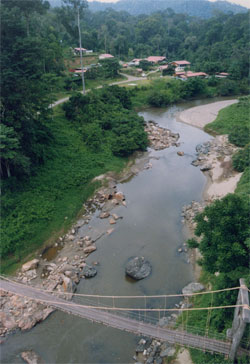 Danum Valley Field Center |
“You can find most of the best timber species in these [dipterocarp] forests,” Sinun said. One is the Belian tree, now increasingly rare because of heavy logging and high demand.
“It grows very slowly, so its fibers are dense, making it an important building structure for houses in this part of the world,” Sinun explained. Belian wood is also prized among indigenous people such as the Orang Sungai, who use it for coffins in their burial caves.
Flying animals, birds’ nests, and stinky flowers
Danum Valley is Yayasan Sabah’s first and oldest conservation area, housing the state’s largest protected lowland dipterocarp forest. The preserve covers 169 square miles, about two and a half times the size of the District of Columbia. All kinds of interesting creatures call this place home, including the banteng, a type of wild cattle; sun bears, the smallest members of the bear family; the Bornean pygmy elephant; and the leopard cat, Borneo’s most common small wild feline. The forest also teems with gliding animal species, from flying frogs and lizards to squirrels. With its two-story structure—a taller canopy looming over a lower one—the ability to swing or glide from one layer to another has proven extremely useful for these animals. In the nearby Madai Caves, the Idahans, another indigenous group, have been harvesting birds’ nests (a Chinese delicacy) for over 21 generations. And Rafflesia Hill is named for Sabah’s state flower, which grows there. It’s a huge red-and-white splotchy mass that can weigh as much as 10 kilograms, with a vile odor not unlike that of rotting meat.
Back in 1984, Yayasan Sabah set up a field center for research in Danum Valley, which has since thrived on support from the Royal Society in the U.K., Shell, Petronas (Malaysia’s oil and gas company), and the British and Canadian High Commissions.
“Many scientists think this center is one of the three best sites in the world for tropical forest research,” Sinun said. “We [at Yayasan Sabah] don’t provide research funds, but the center attracts people anyway who raise their own funding for independent studies.”
“The Land of the Giant Staircase”
The foundation’s second conservation area, Maliau Basin, is also known as “Sabah’s Lost World.” It’s one of the planet’s few relatively untouched wilderness areas.
“It was unknown to the rest of the world until a pilot nearly crashed into one of its mist-shrouded cliffs in 1947,” Sinun said. “Before this, only the Murut people in Sabah had encountered its seven-tiered waterfalls and many other step-like rivers; that’s why they named this place ‘Land of the Giant Staircase,’ in their language.”
Even now, explorers have covered less than half of Maliau Basin, which ecologists have described as a virtually self-contained ecosystem. “We’ve found a high degree of endemism in this area,” Sinun explained, “which shows that at least some of the species that have evolved within this confined space live independently from the surrounding forests.” The basin’s many rivers eventually drain through only one outlet to the great Kinabatangan, Sabah’s main artery, he added.
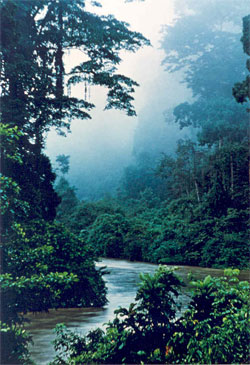 Sabah river |
About 40% of this conservation area will be sealed off as a heritage zone for the next 50 years, according to Sinun. This, he hopes, will give future generations “the same sense of wonderment at this unexplored wilderness.” In the meantime, Sinun has established the Maliau Basin Study Center—modeled after its prototype in Danum Valley—an accomplishment that gives him great pride. Researchers have also created a “Biodiversity Corridor” that links Maliau Basin to the south and Danum Valley to the east.
“The idea is to maintain an area covered with natural forest between both conservation areas, so neither becomes isolated,” Sinun said. “It avoids inbreeding among wildlife populations, allowing for gene transfer from one population to another.”
Virility-enhancing plants and more
The third conservation zone overseen by Sinun is Imbak Canyon, just north of Maliau Basin. Ecologists have hailed it as a potential botanical gene bank for the rehabilitation of forests. One of the popular plants found here, Eurycoma longifolia—called Tongkat Ali (literally, “Ali’s walking stick”) by locals—is widely recognized for its supposed ability to boost testosterone levels. There’s also the ginseng root, containing as many as 42 trace elements and minerals. Chief among them is germanium, which in its organic form may help increase oxygen supply in the blood.
This conservation area is not nearly as well known as either Danum Valley or Maliau Basin, however. Sinun hopes to turn that around soon by establishing a similar research center there, particularly to explore the region’s medicinal plants and herbs. A foundation-organized scientific expedition in 2004 discovered more than 55 different plant species in the canyon’s depths.
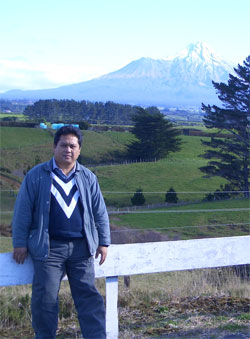 Sinun |
Sinun only wishes he had more time to spend on research, instead of being perpetually swamped with administrative paperwork at the foundation. “I can honestly say that my forest hydrology knowledge has been obsolete for the last 10 years,” he said ruefully. “In Malaysia, unless you’re in the academic world, once you get your Ph.D. or other degrees, you usually wind up doing management work.” Still, whenever possible, he’ll either join in or help organize scientific expeditions to one of the conservation areas.
“It’s how I get to see the forests and mix with academicians again,” he said. “I enjoy being out there with people who know what they’re talking about.”
Balancing the use of natural resources
Sinun doesn’t call himself a conservationist. Rather, he’s a pragmatist in the face of human-caused environmental pressures. “I’ve been involved in some of the very important decisions that shaped, perhaps permanently, the land uses in Sabah; that’s why I love my work,” he said.
He’s no tree-hugger, either.
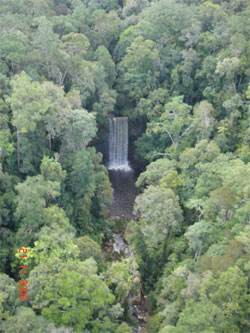 Maliau Basin waterfall |
“If not for the logging and timber extraction activities that Yayasan Sabah also carries out, I wouldn’t have achieved this level of education,” he said. “I believe in development and using natural resources, but in a sustainable way. For example, if you know that forests as a whole grow at a certain rate each year, then you can extract a particular volume from that area without jeopardizing the forest’s ability to regrow. We need sufficient knowledge about our natural resources, and then we need to apply that knowledge in sensible ways.”
Sabah is a young entity of Malaysia, having only joined the country in 1963. As the “immediate post-independence generation,” Sinun and his colleagues have done what they can to shape the country’s second-largest state.
“I hope future and younger generations appreciate our work,” Sinun said, “and that they continue to maintain it, while at the same time remedying any mistakes my generation may have created.”
Alissa Poh is a graduate student in the Science Communication Program at the University of California, Santa Cruz.